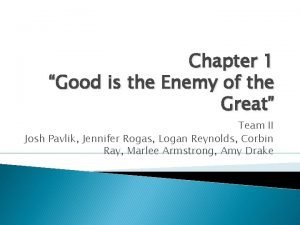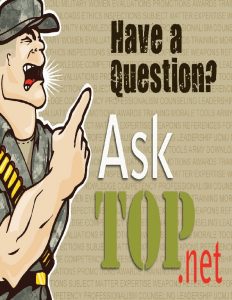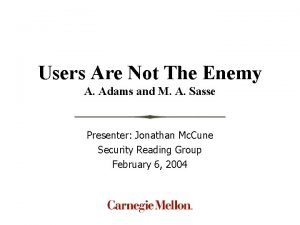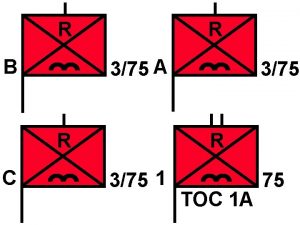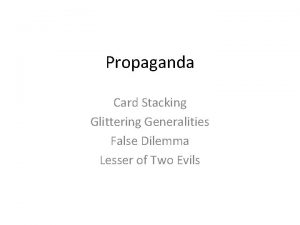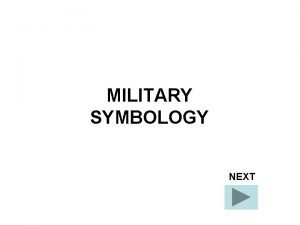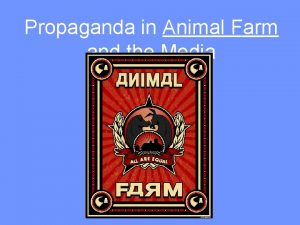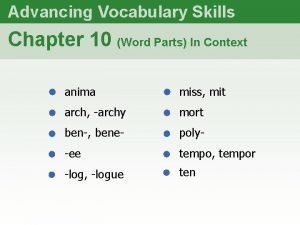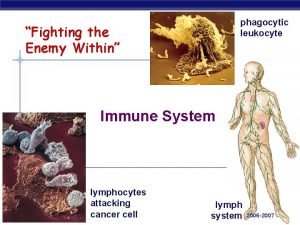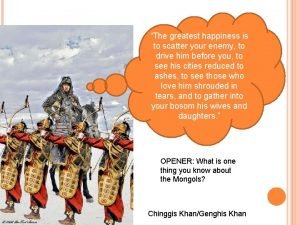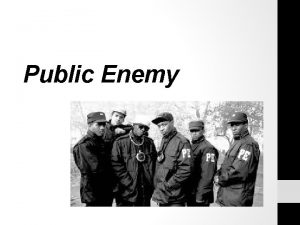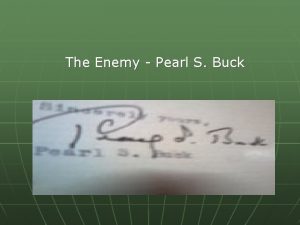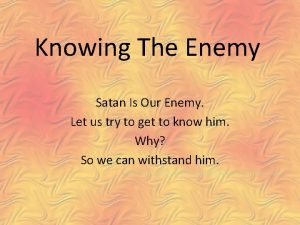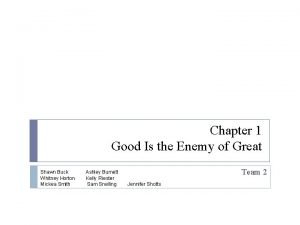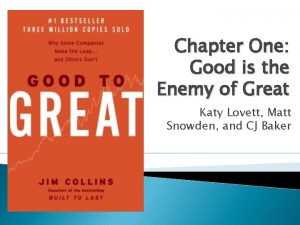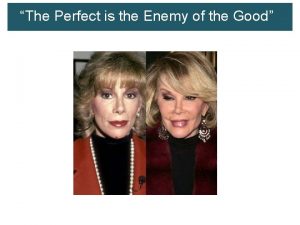Chapter 1 Good is the Enemy of the
























- Slides: 24

Chapter 1 “Good is the Enemy of the Great” Team II Josh Pavlik, Jennifer Rogas, Logan Reynolds, Corbin Ray, Marlee Armstrong, Amy Drake

Brief Overview � Good to Great � Good is the Enemy of Great ◦ Prequel to “Built to Last” � 4 Phases � Level 5 Leadership � Timeless Physics

Phase I: The Search � Good-to-great pattern: ◦ 15 -year returns at or below market ◦ Transition point ◦ 15 -year returns at least three times market � Other criteria: ◦ Pattern independent of company’s industry � Should additional criteria be used with stock returns?

Selection Process � Cut 1 - 1, 435 companies � Cut 2 - 126 companies � Cut 3 - 19 companies ◦ Fortune 500, 1965 -1995 ◦ Used data from University of Chicago Center for Research in Security Prices ◦ Selected companies that had above-average returns preceded by average or below-average returns ◦ Eliminated companies that did not follow exact good-to-great pattern

� Cut 4 - 11 companies ◦ Eliminated companies that did not show transition relative to industry

11 Good-to-Great Companies Abbott Nucor Circuit City Philip Morris Fannie Mae Pitney Bowles Gillette Walgreens Kimberly-Clark Wells Fargo Kroger

Phase II: Compared to What? � Good-to-Great VS Comparison Companies ◦ Distinguishing Factors � Direct Comparison Companies ◦ Same Industry/Opportunities ◦ Similar Resources at Transition ◦ No Leap from Good to Great � Unsustained Comparison Companies ◦ Short Term shift Good-to-Great ◦ Failed to Sustain

Entire Study Set Good-To-Great Companies Direct Comparison Companies Abbott Upjohn Circuit City Silo Fannie Mae Great Western Gillette Warner-Lambert Kimberly-Clark Scott Paper Kroger A&P Nucor Bethlehem Steel Philip Morris R. J. Reynolds Pitney Bowes Addressograph Unsustained Comparison Companies Walgreens Eckerd Burroughs Wells Fargo Bank of America Chrysler Harris Hasbro Rubbermaid Teledyne

Phase III Inside The Black Box � The research compared good companies to great companies � Research was gathered through evidence of key data � Material was coded into categories � Research included interviews of executives during transformation � Extensive analysis

Phase III Extensive Analysis � The ◦ ◦ ◦ ◦ research included extensive analysis of Acquisitions and mergers Executive compensation Business strategy Corporate culture Layoffs Leadership and management styles Financial ratios

Phase III Key Findings � 10 to 11 great companies, CEO’s came from within the company � Executive compensation is a key component of transformation � Long range strategic planning has no direct correlation � Focus on what not to do and what to stop doing

Phase III Key Findings Cont’d � Technology advances transformation, it does not create it � Two mediocre companies cannot equal one great one � Commitment, leadership, and motivation flourish under the right circumstances � Most great transformations are made unaware � Greatness is a matter of choice, not circumstance

Phase IV: Chaos to Concept � Interactive ◦ ◦ ◦ Process of looping back and forth Developing Ideas Testing them against the data Revising the ideas Building framework Watching it break under the weight of evidence Rebuilding it yet again

Phase IV: Chaos to Concept � Process � Reach is repeated continually coherent framework of concepts � Every primary concept showed up as a change variable in 100% of the good to great companies. � Transformation Process: Disciplined People, Disciplined Thoughts, Disciplined Action

Phase IV: Chaos to Concept � Transformation Process Stages: ◦ Disciplined People �Leadership, First Who…Then What ◦ Disciplined Thoughts �Confront Brutal Facts, Hedgehog Concept ◦ Disciplined Action �Culture of Discipline, Technology Accelerators

Level 5 Leadership � What type of leaders take a good company to great? � Do not share the characteristics of high profile leaders � They are self-effacing, quiet, reserved, and even shy � A blend of personal humility and professional will

First Who… Then What � How do good-to-great leaders begin the process to greatness? � Got the right people on the bus � Took the wrong people off the bus � Got the right people in the right seats � Then figured out where to drive the bus

Stockdale Paradox � Good-to-great companies embrace the Stockdale Paradox ◦ 1. Maintain faith you will prevail ◦ 2. Confront the brutal facts of reality

The Hedgehog Concept � Good-to-great companies rise above the curse of competence � Because something is your core business, does not mean you can be the best at it � If you can’t be the best at it, then it cannot be the basis of a great company

Culture of Discipline � Good-to-great companies create a culture of discipline � If you have disciplined people, hierarchy is not needed � If you have disciplined thought, bureaucracy is not needed � If you have disciplined action, excessive controls are not needed

Technology Accelerators � Good-to-great companies think differently about the role of technology � Use technology to ignite transformation � Technology is not used as a primary cause of greatness � Pioneers in “carefully selected technologies”

Timeless “Physics” � Jim Collins states that we should continually search for timeless principles that will remain true and relevant no matter how the world changes around us � Example: Wells Fargo

Economy � It does not matter what kind of economy we are in to apply these timeless principles � Example: Apple and Steve Jobs

Conclusion being the enemy great is a human problem � Good � Any type of organization can be transformed using timeless principles
 Good is the enemy of the great
Good is the enemy of the great Good words good thoughts good deeds
Good words good thoughts good deeds Hi good evening google
Hi good evening google Buenas tardes good afternoon
Buenas tardes good afternoon You are good you are good when there's nothing good in me
You are good you are good when there's nothing good in me Good afternoon me
Good afternoon me An opponent or enemy
An opponent or enemy Overlay symbols
Overlay symbols Yahoomail7
Yahoomail7 Paul bacon waseda
Paul bacon waseda Remains simon armitage
Remains simon armitage Arc375
Arc375 Card stacking examples
Card stacking examples Simplification propaganda
Simplification propaganda Expected armored cavalry troop symbol
Expected armored cavalry troop symbol Enemy corner seating arrangement
Enemy corner seating arrangement We're not ignorant of his devices
We're not ignorant of his devices Nnnn enemy
Nnnn enemy British army section battle drills
British army section battle drills Enemy of luke skywalker
Enemy of luke skywalker Animal farm propaganda poster
Animal farm propaganda poster Holmes' arch enemy is _____.
Holmes' arch enemy is _____. The devil only comes to steal kill and destroy
The devil only comes to steal kill and destroy My enemy y y y
My enemy y y y The greatest happiness is to scatter your enemy
The greatest happiness is to scatter your enemy
